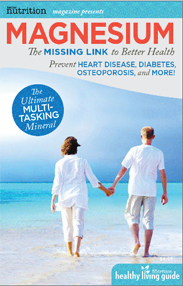Osteoporosis, Poor Bone Health and the Case for Magnesium and Healthy Bone Development
 Osteoporosis is neither a normal nor inevitable consequence of aging: Our bones were designed to last a lifetime. Popular wisdom, however …
Osteoporosis is neither a normal nor inevitable consequence of aging: Our bones were designed to last a lifetime. Popular wisdom, however …
… is that osteoporosis in women is due to a decrease in estrogen levels with age. Doctors therefore rely on estrogen, calcium, and drugs that stimulate bone formation to treat osteoporosis. The National Institutes of Health (NIH) Osteoporosis Prevention, Diagnosis, and Therapy Consensus Statement of 2000 was developed from a conference including eighty experts, but no mention of magnesium deficiency as a causative factor in osteoporosis was made in the final report.1
With drug companies funding most of the osteoporosis research, there are no large clinical trials investigating the magnesium connection in bone production. Although we were able to find over 22,000 journal articles on osteoporosis, there were only ten in the past decade that studied the magnesium connection in humans. As long as people are given false hope that there is some magic bullet in the pharmaceutical pipeline that will cure osteoporosis, or any other chronic disease, they will ignore the underlying diet- and nutrient-related reasons for their health problems.
The recent report that Fosamax causes jawbone deterioration is evidence that this drug, and likely all bisphosphonates, cause brittle bones. Fosamax destroys osteoclasts, the cells that remodel bone (sculpt the bone as new bone forms). Fosamax is therefore supposed to prevent bone breakdown but the drug companies did not reckon with the bone-remodeling function of the osteoclast. X-rays of bones under the influence of Fosamax may look like they have more calcium but without the remodeling capacity the bones internal structure is in disarray, and bones are more brittle, and may actually break more easily.
When you read the scientific literature, there is ample evidence that many nutrients, especially magnesium, play a crucial role in bone development. Much animal research, for example, proves that magnesium depletion alters bone and mineral metabolism, which results in bone loss and osteoporosis. 5, 6 Magnesium deficiency is very common in women with osteoporosis compared to controls. 2
In one study, postmenopausal women with osteoporosis were able to stop the progression of the disease with 250-750 mg of magnesium daily for two years. Without any other added measures, 8 percent of these women experienced a net increase in bone density. 3
A group of menopausal women given a magnesium hydroxide supplement for two years had fewer fractures and a significant increase in bone density. 4
Another study showed that by taking magnesium lactate (1,500-3,000 mg daily for two years), 65 percent of the women were completely free of pain and had no further degeneration of spinal vertebrae.5
Magnesium in conjunction with hormonal replacement improved bone density in several groups of women compared to controls.6, 7
In fact, if you are taking estrogen and have a low magnesium intake, calcium supplementation may increase your risk of thrombosis (blood clotting that can lead to a heart attack). 8
It is unfortunate that the treatment for osteoporosis has been simplified into the single battle cry “Take calcium”. Calcium dominates every discussion about osteoporosis, is used to fortify dozens of foods (including orange juice and cereal), and is a top-selling supplement, but it cannot stand alone.
Calcium and magnesium work so closely together that the lack of one immediately diminishes the effectiveness of the other. Even though the use of calcium supplementation for the management of osteoporosis has increased significantly in the last decade, scientific studies do not support such large doses after menopause. Soft tissue calcification could be a serious side effect of taking too much calcium. 9
Osteoporosis is generally a progressive disease, and some say it is incurable, but if you avoid the risk factors that are under your control, take a good range of bone-building nutrients, and exercise, you can halt the condition even if you have the symptoms. Prevention is the best defense, the key elements of which are:
Eat a balanced, nutrient-rich diet.
Take supplements of calcium, magnesium, and the various bone support factors.
Practice a vigorous exercise program throughout life.
References:
1. The National Institutes of Health Osteoporosis Prevention, Diagnosis,and Therapy Consensus Statement, Mar. 2000.
2. Brodowski J, Levels of ionized magnesium in women with various stages of postmenopausal osteoporosis progression evaluated on the basis of densitometric examinations. Przegl Lek, vol. 57, no. 12, pp. 714-716, 2000.
3. Sojka JE, Weaver CM, Magnesium supplementation and osteoporosis. Nutrition Reviews, vol. 53, p. 71, 1995.
4. Goldberg B, Alternative Medicine Guide: Women’s Health Series 2, Future Medicine Publishing, Tiburon, CA, 1998.
5. Dreosti IE, Magnesium status and health. Nutrition Reviews, vol. 53, no. 9, pp. 523-527, 1995.
6. Abraham GE, Grewal HA, Total dietary program emphasizing magnesium instead of calcium: effect on the mineral density of calcaneous bone in postmenopausal women on hormonal therapy. Journal of Reproductive Medicine, vol. 35, no. 5, pp. 503-507, 1990.
7. Seelig MS, Increased magnesium need with use of combined estrogen and calcium for osteoporosis. Magnesium Res, vol. 3, pp. 197-215, 1990.
8. Goldberg B, Alternative Medicine Guide: Women’s Health Series 2, Future Medicine Publishing, Tiburon, CA, 1998.
9. Brown S, Better Bones, Better Body, Keats Publishing, New Canaan, CT, 1996.
Newsletter
![]()

Want valuable information regarding the health benefits of magnesium, latest studies, expert interviews,videos and health tips? Enter your name and email address and you can start receiving valuable health information right away.
Featured On:








